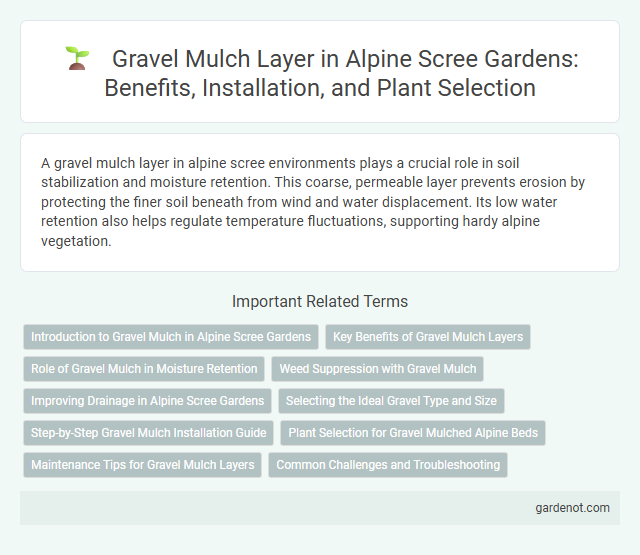A gravel mulch layer in alpine scree environments plays a crucial role in soil stabilization and moisture retention. This coarse, permeable layer prevents erosion by protecting the finer soil beneath from wind and water displacement. Its low water retention also helps regulate temperature fluctuations, supporting hardy alpine vegetation.
Introduction to Gravel Mulch in Alpine Scree Gardens
Gravel mulch in alpine scree gardens creates a well-draining, erosion-resistant surface that mimics natural mountain habitats. This layer stabilizes soil moisture, reduces weed growth, and provides essential mineral content for alpine plants. Using appropriately sized gravel enhances root aeration and supports the unique microclimate required for scree vegetation.
Key Benefits of Gravel Mulch Layers
Gravel mulch layers in alpine scree environments improve soil drainage and reduce erosion by stabilizing the substrate. They enhance moisture retention while preventing weed growth, promoting healthier plant root development in harsh conditions. This mulch technique also moderates soil temperatures, creating a more favorable microclimate for alpine flora survival.
Role of Gravel Mulch in Moisture Retention
Gravel mulch plays a crucial role in moisture retention by reducing surface evaporation and enhancing water infiltration in alpine scree environments. Its porous structure allows rainwater to permeate while shielding the soil from direct sunlight, thereby maintaining consistent moisture levels essential for plant survival. This protective layer also minimizes soil temperature fluctuations, promoting a stable microclimate that supports alpine flora.
Weed Suppression with Gravel Mulch
Gravel mulch layers in alpine scree gardens create an effective barrier that minimizes weed growth by blocking sunlight and limiting seed germination. This layer enhances soil moisture retention while reducing competition from invasive species, promoting healthier native plant development. Properly applied gravel mulch supports sustainable weed management, preserving the delicate ecosystem of alpine scree environments.
Improving Drainage in Alpine Scree Gardens
Gravel mulch layers significantly enhance drainage in alpine scree gardens by allowing rapid water infiltration and reducing surface runoff. This improved drainage prevents waterlogging, which is critical for the survival of drought-tolerant alpine plants that require well-drained soil conditions. Incorporating a gravel mulch layer also helps maintain aeration around root zones, promoting healthier root development and reducing the risk of root rot.
Selecting the Ideal Gravel Type and Size
Selecting the ideal gravel type and size for an alpine scree gravel mulch layer is crucial for effective drainage and soil stabilization. Coarse, angular gravel between 10 to 30 millimeters promotes root aeration and prevents compaction, while finer gravel may impede water flow and encourage moss growth. Opting for locally sourced granite or basalt gravel enhances natural integration and durability in harsh alpine environments.
Step-by-Step Gravel Mulch Installation Guide
To install a gravel mulch layer on alpine scree, start by clearing the area of debris and leveling the surface to ensure proper drainage. Next, lay down a geotextile fabric to prevent weed growth and maintain soil stability beneath the gravel. Finally, evenly spread a 2-3 inch layer of angular gravel, such as crushed granite or basalt, which promotes water retention and reduces erosion in alpine environments.
Plant Selection for Gravel Mulched Alpine Beds
Gravel mulch layers in alpine scree beds improve drainage and reduce soil moisture fluctuations, which is essential for selecting drought-tolerant and well-draining plant species such as Sedum, Saxifraga, and Sempervivum. These plants thrive in gravel mulch by minimizing root rot risks and enhancing nutrient absorption. Proper plant selection ensures healthy growth and mimics natural alpine scree environments effectively.
Maintenance Tips for Gravel Mulch Layers
Maintaining a gravel mulch layer on alpine scree involves regular removal of debris and organic matter to prevent weed growth and maintain soil aeration. Raking the gravel periodically helps redistribute stones evenly, avoiding compaction and promoting proper drainage essential for alpine plant roots. Inspecting the mulch for displacement after storms or heavy rain ensures the protective layer remains effective against soil erosion and temperature fluctuations.
Common Challenges and Troubleshooting
Gravel mulch layers in alpine scree gardens often face challenges such as erosion caused by wind and heavy rainfall, which can displace the gravel and expose soil beneath. Poor drainage within the gravel mulch can lead to waterlogging, promoting root rot in alpine plants adapted to well-drained conditions. To troubleshoot these issues, ensure proper installation with a geo-fabric barrier, maintain an adequate gravel depth of 5-7 cm, and regularly inspect the layer to redistribute displaced stones and improve soil stability.
Gravel mulch layer Infographic

 gardenot.com
gardenot.com